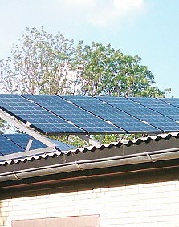This page is part of a series on tilt angles.
An intro is at tilt angle.
The other pages are:
load tilts
optimal tilt,
tilt deviation,
and comparing tilts
As we point out in our pages on sun angle and insolation, in a given sunny moment, you gather the most solar radiation by tilting your solar panels so that the sunlight hits them directly. This is the basic idea behind tilt angles.

The solar radiation you capture by having beams of sunlight hit your solar panel directly is direct radiation.
Since the sky's diffuse radiation is not travelling in any one direction but is going every which way, you actually gather the most diffuse radiation by laying your solar panels out flat (see types of radiation).
Typically, tilt angle formulas only take direct radiation into account but some more involved methods for choosing a tilt angle also take diffuse radiation into account.
Because a large portion of the annual solar radiation in the sky of very cloudy climates is diffuse radiation, solar panels in such climates do better with a tilt that is shallower than what most tilt angle formulas recommend. This and other details of the limitations of tilt angle formulas is covered on optimal tilt.
How close to optimal is close-enough? How much solar energy do we lose if we just put our solar panels on a South-facing roof and don't worry about optimal tilt? Or, how much energy do we lose if we don't point our solar panels due South (or due North in the Southern Hemisphere - explained at the bottom of the page).
And how much better can we do with something more involved than a permanently fixed tilt angle? How much solar energy do we gain if we adjust our tilts to match the seasons or - even better - have two axis tracking and can constantly follow the sun?
These questions are answered in detail on tilt deviation. Here we'll just make a few general remarks. For the purposes of this discussion I'll assume you are in the Northern Hemisphere.

If you have a South-facing roof with a medium pitch and are not too terribly close to the equators or the poles (like say you're between 20° and 50° North), chances are good that simply mounting your solar panels on your roof (at "roof-pitch") will cost you a very insignifigant (if any) amount of annual solar energy.
If, on the other hand, you face your solar panels to the Southeast or Southwest (aka: 45° away from due South - angles are covered on definitions), you will generally sacrifice about 5% (or more; less if you live close to the equator) of your annual solar energy.
And facing your solar panels due East or West (aka: 90° away from due South) costs you so much solar energy that in these cases you generally do better with no tilt at all (horizontal solar panels).
Two-axis tracking usually nets you about 20% (sometimes 30%) more solar energy per year than an optimal annual tilt angle.
Finally, my investigation of seasonally adjusted tilt included less cities than my other investigations, but it seems that at least in cities at typical US latitudes (30° - 42° North), adjusting seasonally adds at least 4% and could - in some cities - do considerably better.
Again, all this information is covered in much more detail on tilt deviation.
To keep things simple, most of our tilt angle pages focus primarily on optimal annual tilt angles - permanently fixed tilts that optimize the amount of solar energy gathered in a year.
However, that is not the best tilt angle for every situation. We discuss some common situations (various energy needs, relationships to the electricity grid, etc) and the corresponding tilt angles on load tilts.

Before we get to our blustery warnings ("Focus on Fundamentals First"), let's have a quick explanation of why it is genearlly best to point your solar panels due South in the Northern Hemispher and due North in the Southern Hemisphere.
At latitudes farther to the North of the equator than the Tropic of Cancer (currently about 23.5° North), the sun stays in the Southern part of the sky year-round and is due South at solar noon (middle of the day - the daily high-point for the sun).
At latitudes between the equator and the Tropic of Cancer, the sun spends most of the year in the Southern part of the sky (only at the equator is the sun evenly divided between the Northern and Southern parts of the sky).
So, in the Northern Hemisphere, all other things being equal (ie: shade from trees, clouds, etc don't interfere), you gather the most sun if your tilted solar panels are pointed due South (as in "true South", not "magnetic South").
The opposite situation is found in the Southern Hemisphere and so solar energy systems in the Southern Hemisphere generally tilt due North.
In any case, it seems obvious that before you bother with solar energy, you should make sure you are using energy as efficiently as possible. The biggest "bang for our buck" in terms of both saving money and resources is generally efficiency. Why even contemplate solar energy before you've figured out how to improve your relationship to energy in cheaper, easier and less-risky ways?
Also, before you pick a tilt angle, you or a professional have to do a solar site survey (that's when you analyze how shading could effect your site throughout the year). Shading from trees, buildings, clouds, etc. can really wreck a PV systems performance and if you are not careful you can end up spending a lot of time and money for a lot less energy than you had thought you were going to get.
We compare some common methods for choosing an optimal annual tilt at optimal tilt.
On tilt deviation we examine how much energy is lost if your tilt angle is lower, higher or to the East or West of the optimal annual tilt angle. And on that page we even look at how much extra energy you could expect to gain by adjusting your tilt seasonally.
If this page has been a help to you
please recommend it with Google+ below: